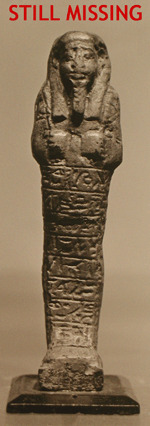Well, that was quick: The U.S. Immigration and Customs Enforcement announced today that
 it has recovered seven of the eight ancient Egyptian artifacts that were stolen from the Bijbels Museum in Amsterdam in the middle of the afternoon on July 29, 2007. The Art Loss Register found them at a Manhattan auction house when it perused sale-catalogue galleys circulated to ALR (the usual practice). It called Customs, which had been asked by the Dutch police to help.
it has recovered seven of the eight ancient Egyptian artifacts that were stolen from the Bijbels Museum in Amsterdam in the middle of the afternoon on July 29, 2007. The Art Loss Register found them at a Manhattan auction house when it perused sale-catalogue galleys circulated to ALR (the usual practice). It called Customs, which had been asked by the Dutch police to help.
One earthenware piece, Shabti of Ptah-Irdisu, 1300-1200 BCE, picture at right, is still missing.
When I called Christopher A. Marinello, ALR’s executive director, he declined to name the auction house, but he said that it was one of the big two — Christie’s and Sotheby’s. He called the case a “textbook” example of what should happen in art thefts because everyone — Customs, ALR, the Dutch police, the auction house and the consigner — cooperated.
The consigner said he bought the artifacts from a Russian gentleman who lived in Ireland. The Russian claimed he had owned the pieces since 1939, according to Marinello. ALR declined to value the items and said the auction catalogue did not yet carry estimates.
ALR described one recovered piece as a 7-inch-tall Shabti figure with arms folded over the chest and tools in each hand, dating to 1307 – 1070 BCE. Others include a bronze figure of Imhotep, one of Horus as a child, and a painted wooden Osiris figure, all dating as far back as 712 BCE.
Photo Credit: Courtesy of Art Loss Register
